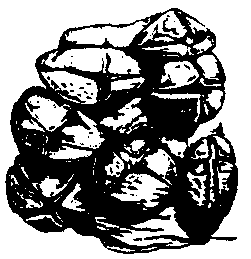
| Palaeos: |  |
Rhynchonelliformea |
| Brachiopoda | Pentamerida |
| Page Back | Page Up | Unit Home | Metazoa |
| Page Next | Page Down | Dendrogram | Glossary |

Pentamerids differ from other articulates in the structure of the rear portion of the pedicle valve, which has a spoon-shaped structure called a spondylium. The shell microstructure is impunctate. The shell is often five-sided (pentagonal) in outline - hence the name. The hinge line is short. The fold and the sulcus are reversed in regard to other brachiopods, with the fold on the pedicle valve.
![]() These
biconvex (left) shells appeared in mid-Canibrian seas, became common
in the Ordovician, and lived on to the end of Devonian times. The Silurian
Pentamerus laevis lived in closely packed colonies with pedicles sunk into the
mud and elongate shells directed upward. Such colonies are often found
on the under side of beds of fine sandstones. When cleaned and exhibited
in museums, they appear upside down. Often there was pedicle attachment
at all, and the animals lived in self-supporting colonies like the one
illustrated above.
These
biconvex (left) shells appeared in mid-Canibrian seas, became common
in the Ordovician, and lived on to the end of Devonian times. The Silurian
Pentamerus laevis lived in closely packed colonies with pedicles sunk into the
mud and elongate shells directed upward. Such colonies are often found
on the under side of beds of fine sandstones. When cleaned and exhibited
in museums, they appear upside down. Often there was pedicle attachment
at all, and the animals lived in self-supporting colonies like the one
illustrated above.

Brachiopoda main page |